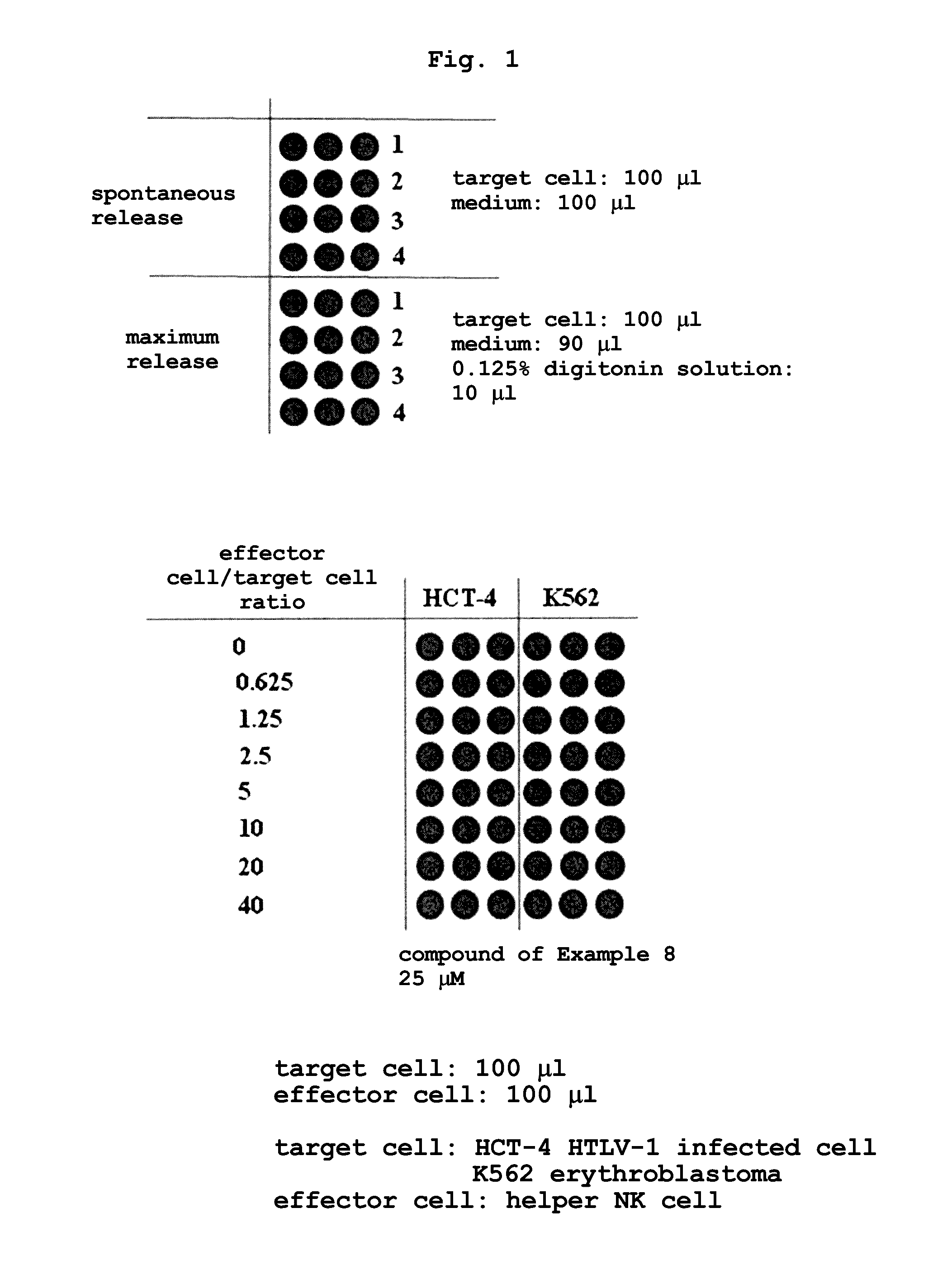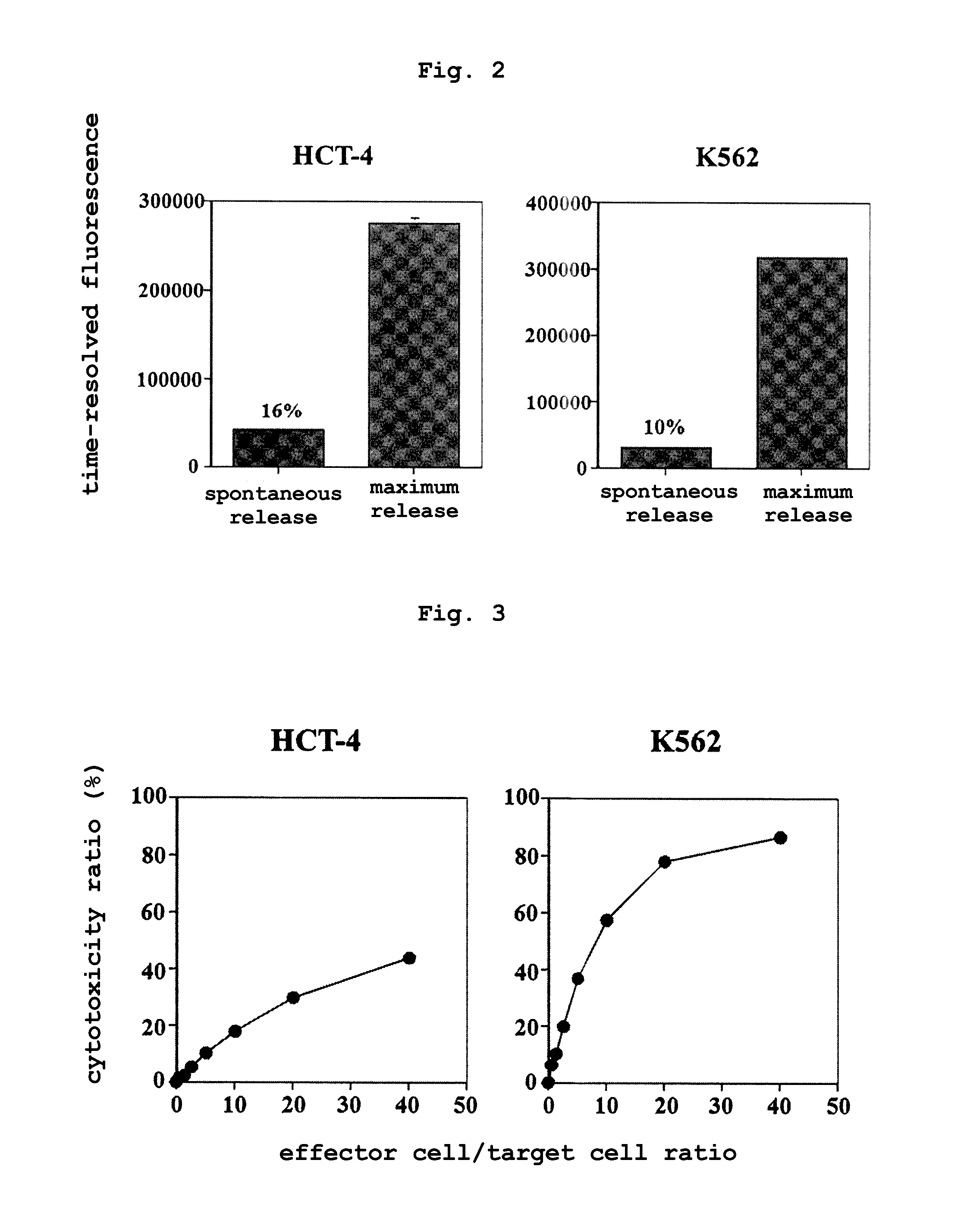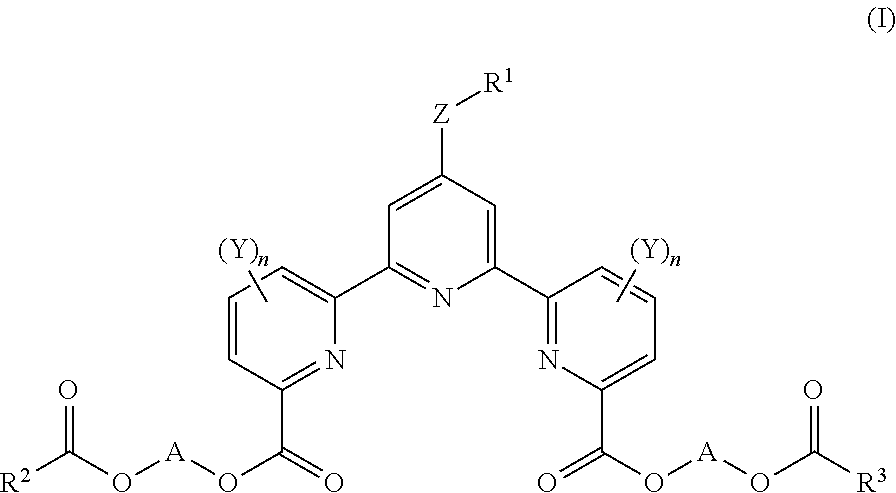Rapid method for measuring cytotoxicity in non-ri system
a cytotoxicity and non-ri technology, applied in the field of compounds for measuring cytotoxicity using non-ri, can solve the problems of ineffective treatment, lack of broad utility, difficult to adopt in the clinical site, etc., and achieve the effects of improving the polarity of chelate compounds, high producibile and convenient, and improving treatment effects
- Summary
- Abstract
- Description
- Claims
- Application Information
AI Technical Summary
Benefits of technology
Problems solved by technology
Method used
Image
Examples
example 1
bis(butyryloxymethyl) 4′-(2-hydroxyethoxy)-2,2′:6′,2″-terpyridine-6,6″-dicarboxylate
(Step 1)
[0149]
[0150]According to the method described in the above-mentioned
[0151]Method A, step 1 (2.5 mmol scale), and using 2-acetoxyethylbromide as an electrophilic reagent, the reaction was performed. The obtained crude product was purified by flash column chromatography (eluent: 50% n-hexane / ethyl acetate) to give diethyl 4′-(2-acetoxyethoxy)-2,2′:6′,2″-terpyridine-6,6″-dicarboxylate (494 mg, yield 41%) as an orange solid.
[0152]1H NMR (500 MHz, CDCl3) δ 1.48 (t, J=7.1 Hz, 6H), 2.14 (s, 3H), 4.49-4.54 (m, 4H), 4.52 (q, J=7.1 Hz, 4H), 8.00 (t, J=7.8 Hz, 2H), 8.16 (dd, J=1.0, 7.6 Hz, 2H), 8.20 (s, 2H), 8.80 (dd, J=1.0, 7.8 Hz, 2H); 13C NMR (125 MHz, CDCl3) δ 14.3, 20.9, 61.8, 62.4, 66.1, 108.3, 124.3, 125.1, 137.7, 147.8, 156.0, 156.4, 165.2, 166.8, 170.9.
(Step 2)
[0153]
[0154]According to the method described in the above-mentioned Method A, step 2 (0.8 mmol scale), and using diethyl 4′-(2-acetoxye...
example 2
bis(acetoxymethyl) 4′-(2-oxo-2-(propylamino)ethoxy)-2,2′:6′,2″-terpyridine-6,6″-dicarboxylate
(Step 1)
[0159]
[0160]According to the method described in the above-mentioned Method A, step 1 (1.0 mmol scale), and using 2-oxo-2-(propylamino)ethoxymethylbromide as an electrophilic reagent, the reaction was performed. The obtained crude product was purified by flash column chromatography (eluent: 50% n-hexane / ethyl acetate) to give diethyl 4′-(2-oxo-2-(propylamino)ethoxy)-2,2′:6′,2″-terpyridine-6,6″-dicarboxYlate (342 mg, yield 70%) as a white solid.
[0161]1H NMR (500 MHz, CDCl3) δ 0.99 (t, J=7.1 Hz, 3H), 1.50 (t, J=7.4 Hz, 6H), 1.65 (sext. J=7.3 Hz. 2H), 3.38 (q, J=7.9 Hz, 2H), 4.53 (t, J=7.1 Hz, 4H), 6.76 (br. t, NH), 8.01 (t, J=7.9 Hz, 2H), 8.17 (dd, J=1.0, 7.6 Hz, 2H), 8.22 (s, 2H), 8.79 (dd, J=1.0, 7.9 Hz, 2H); 13C NMR (125 MHz, CDCl3) δ 11.3, 14.3, 22.8, 40.9, 61.9, 66.8, 108.2, 124.3, 125.3, 137.8, 147.8, 155.6, 156.7, 165.1, 165.3, 166.9.
(Step 2)
[0162]
[0163]According to the method d...
example 3
bis(acetoxymethyl) 4′-(2-hydroxyethoxy)-2,2′:6′,2″-terpyridine-6,6″-dicarboxylate
(Step 1)
[0168]
[0169]According to the method described in the above-mentioned Method A, step 3 (0.05 mmol scale), and using 4′-(2-hydroxyethoxy)-2,2′:6′,2″-terpyridine-6,6″-dicarboxylic acid and acetoxymethylchloride, the reaction was performed. The obtained crude product was purified by preparative TLC (eluent: chloroform:acetone=4:1) to give the title compound (12 mg, yield 47%) as a white solid.
[0170]1H NMR (500 MHz, CDCl3) δ 2.18 (s, 6H), 4.07-4.10 (m, 2H), 4.42 (t, J=4.5 Hz, 2H), 6.11 (s, 4H), 8.01 (t, J=8.0 Hz, 2H), 8.18 (d, J=8.0 Hz, 2H), 8.21 (s, 2H), 8.81 (d, J=8.0 Hz, 2H); 13C NMR (125 MHz, CDCl3) δ 20.8, 61.1, 65.6, 80.2, 108.5, 124.9, 125.7, 137.9, 146.4, 156.1, 156.3, 163.9, 165.5, 169.6.
PUM
| Property | Measurement | Unit |
|---|---|---|
| reaction time | aaaaa | aaaaa |
| reaction time | aaaaa | aaaaa |
| reaction time | aaaaa | aaaaa |
Abstract
Description
Claims
Application Information
 Login to View More
Login to View More - R&D
- Intellectual Property
- Life Sciences
- Materials
- Tech Scout
- Unparalleled Data Quality
- Higher Quality Content
- 60% Fewer Hallucinations
Browse by: Latest US Patents, China's latest patents, Technical Efficacy Thesaurus, Application Domain, Technology Topic, Popular Technical Reports.
© 2025 PatSnap. All rights reserved.Legal|Privacy policy|Modern Slavery Act Transparency Statement|Sitemap|About US| Contact US: help@patsnap.com



